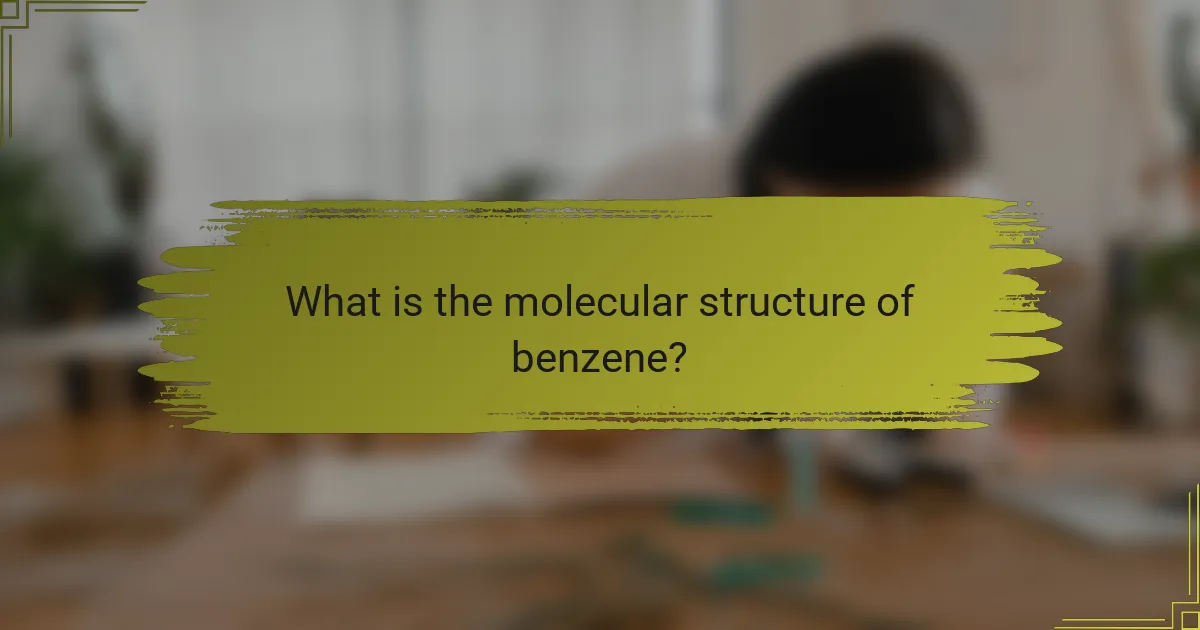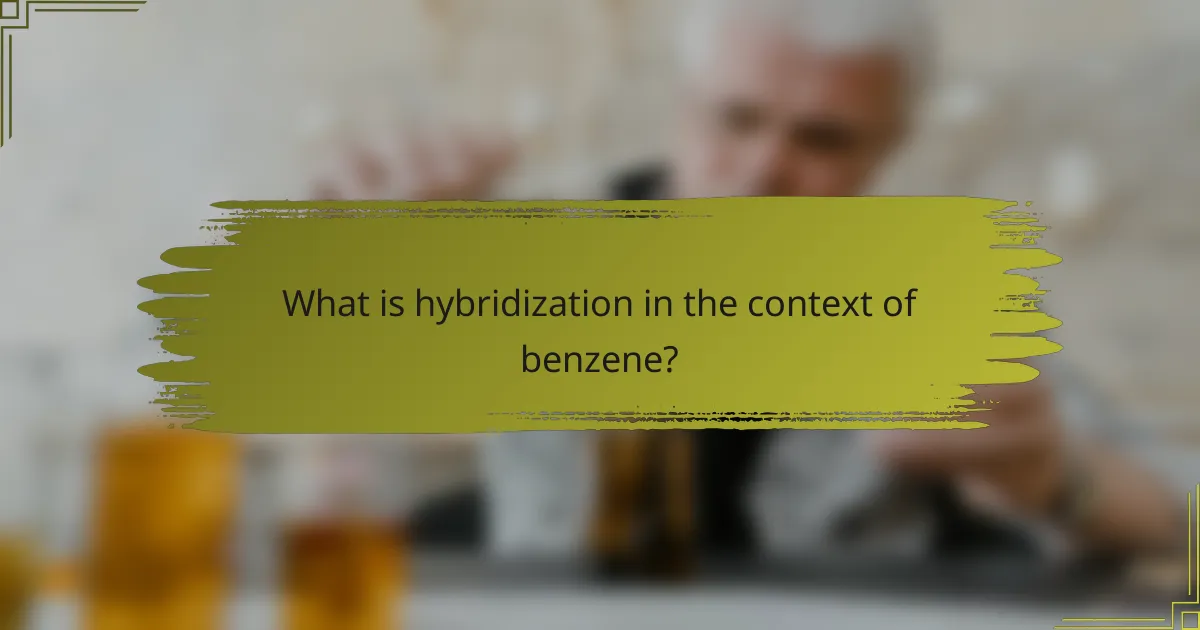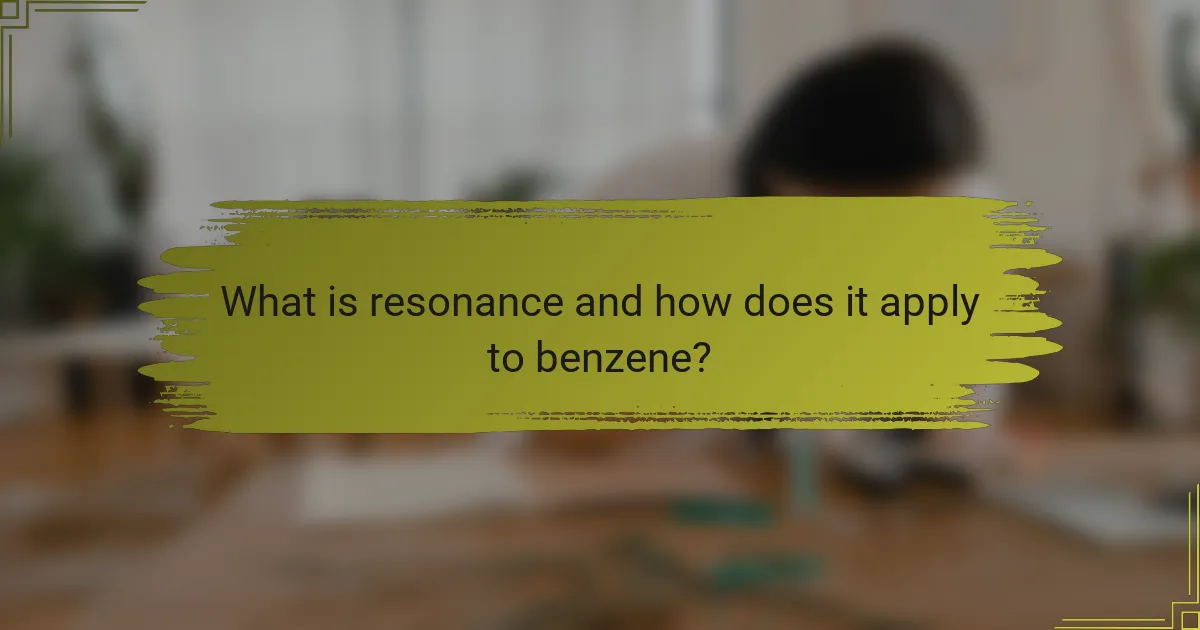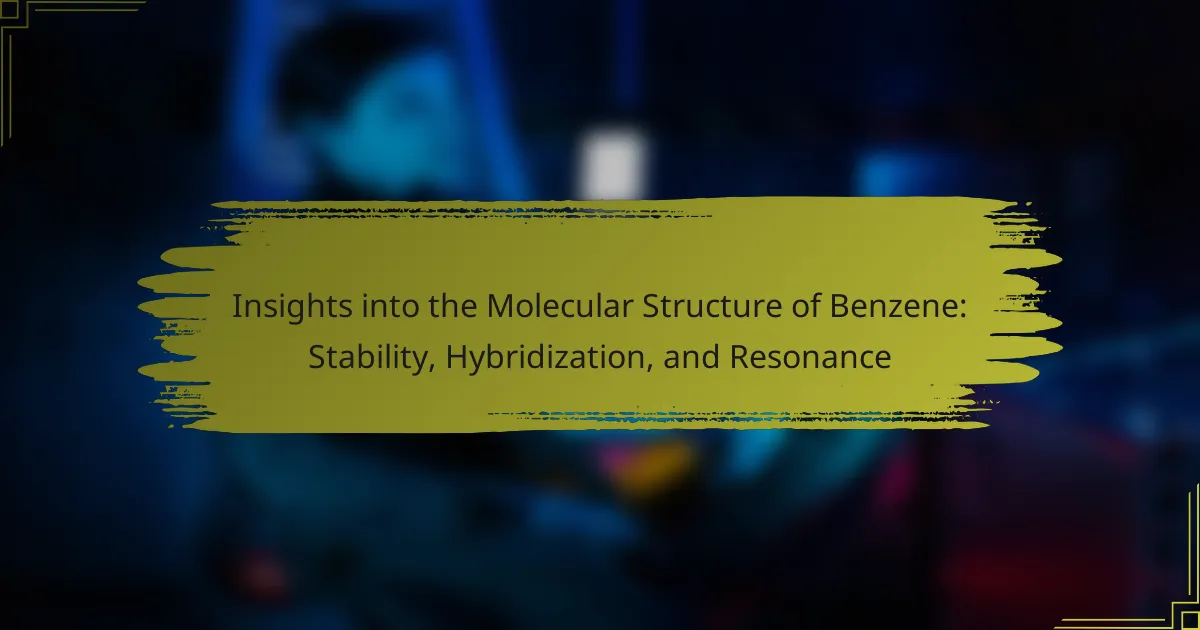
What is the molecular structure of benzene?
Benzene has a molecular structure represented by a hexagonal ring of carbon atoms. Each carbon atom is bonded to one hydrogen atom. The formula for benzene is C6H6. The carbon atoms in benzene are sp2 hybridized. This hybridization results in a planar structure. Benzene exhibits resonance, meaning the electrons are delocalized across the ring. This delocalization contributes to benzene’s stability. The bond lengths in benzene are equal, measuring approximately 1.39 Å. This uniformity is a result of resonance and hybridization.
How is benzene classified in terms of molecular geometry?
Benzene is classified as having a planar, hexagonal molecular geometry. This geometry arises from its six carbon atoms arranged in a ring. Each carbon atom is bonded to one hydrogen atom, forming a symmetrical structure. The bond angles in benzene are approximately 120 degrees. This angle is characteristic of sp2 hybridization. The delocalized pi electrons contribute to the stability of this structure. Benzene’s geometry allows for resonance, enhancing its chemical stability.
What are the key characteristics of benzene’s molecular shape?
Benzene has a planar, hexagonal molecular shape. Each carbon atom in benzene is bonded to two other carbon atoms and one hydrogen atom. This arrangement forms a ring structure with alternating single and double bonds. The bond angles between the carbon atoms are approximately 120 degrees. Benzene exhibits resonance, allowing for equal bond lengths throughout the ring. This resonance contributes to its stability. The uniform distribution of electrons creates a delocalized pi electron cloud above and below the plane. This unique molecular shape is essential for benzene’s chemical properties.
How does benzene’s structure compare to other hydrocarbons?
Benzene’s structure is distinct from other hydrocarbons due to its aromatic nature. It consists of a six-carbon ring with alternating double bonds, represented as a hexagon with a circle inside. This structure allows for resonance, where electrons are delocalized across the ring. In contrast, aliphatic hydrocarbons, like alkanes, alkenes, and alkynes, have linear or branched structures with localized bonds. Alkanes have single bonds, while alkenes and alkynes contain one or more double or triple bonds, respectively. The unique resonance in benzene contributes to its stability, making it less reactive than many other hydrocarbons. This stability is a key characteristic that differentiates benzene from both saturated and unsaturated hydrocarbons.
Why is the stability of benzene significant in chemistry?
The stability of benzene is significant in chemistry due to its unique resonance structure. Benzene has six carbon atoms arranged in a ring, with alternating single and double bonds. However, the actual structure is a resonance hybrid of multiple contributing structures. This resonance leads to lower energy and increased stability compared to non-aromatic compounds.
The bond lengths in benzene are equal, measuring approximately 1.39 Å, indicating that all bonds are equivalent. This uniformity contributes to its chemical stability. Benzene’s stability also makes it less reactive than alkenes, allowing it to undergo substitution reactions rather than addition reactions.
This stability is foundational in organic chemistry, influencing the synthesis of various aromatic compounds. The concept of aromaticity, defined by Hückel’s rule, states that benzene meets the criteria for aromatic stability. Therefore, the stability of benzene is crucial for understanding reactivity patterns in organic molecules.
What factors contribute to benzene’s stability?
Benzene’s stability is primarily attributed to its resonance structure. The delocalization of electrons across the carbon atoms contributes significantly to this stability. Benzene has six carbon atoms arranged in a ring, with alternating double bonds. However, these double bonds are not fixed; instead, they resonate, creating a hybrid structure. This resonance lowers the overall energy of the molecule, making it more stable than expected for a compound with such unsaturation. The bond lengths in benzene are equal, measuring approximately 1.39 Å, indicating that all carbon-carbon bonds are equivalent due to resonance. Additionally, the stability is enhanced by the completion of the octet rule for each carbon atom, ensuring that they are energetically favorable.
How does resonance affect benzene’s stability?
Resonance significantly enhances benzene’s stability. In benzene, resonance involves the delocalization of electrons across the carbon atoms. This delocalization creates a stable electron cloud above and below the plane of the molecule. As a result, the energy of the benzene molecule is lowered compared to localized structures. The resonance energy of benzene is approximately 36 kilocalories per mole. This energy indicates the extra stability provided by resonance compared to theoretical structures without it. Consequently, benzene’s unique resonance structure contributes to its chemical inertness and lower reactivity.

What is hybridization in the context of benzene?
Hybridization in the context of benzene refers to the mixing of atomic orbitals to form new hybrid orbitals. In benzene, the carbon atoms undergo sp2 hybridization. Each carbon atom uses one s orbital and two p orbitals to create three equivalent sp2 hybrid orbitals. These sp2 hybrid orbitals arrange themselves in a planar structure, forming 120-degree angles. The remaining unhybridized p orbital on each carbon atom contributes to the delocalized pi system. This delocalization is responsible for benzene’s stability and unique chemical properties. The sp2 hybridization allows for the formation of sigma bonds with hydrogen atoms and adjacent carbon atoms, contributing to the overall structure of benzene.
How does hybridization contribute to benzene’s structure?
Hybridization contributes to benzene’s structure by enabling the formation of its planar, symmetrical arrangement. In benzene, the carbon atoms undergo sp2 hybridization. This process involves the mixing of one s orbital and two p orbitals from each carbon atom. The result is three sp2 hybrid orbitals that lie in a plane at 120-degree angles. These orbitals form sigma bonds with adjacent carbon atoms and hydrogen atoms. The unhybridized p orbitals on each carbon atom overlap to create a delocalized pi electron system. This delocalization contributes to benzene’s stability and unique properties. The resonance structure of benzene illustrates this stability, as the electrons are not localized but spread over the entire ring. Thus, hybridization is fundamental to benzene’s characteristic structure and stability.
What types of hybridization occur in benzene?
Benzene exhibits sp2 hybridization. Each carbon atom in benzene forms three sigma bonds using sp2 hybrid orbitals. One sp2 orbital forms a sigma bond with a neighboring carbon atom. The other two sp2 orbitals bond with hydrogen atoms. The remaining unhybridized p orbital on each carbon atom overlaps to form a delocalized pi bond system. This arrangement contributes to benzene’s stability and resonance. The sp2 hybridization results in a planar structure with bond angles of 120 degrees.
How does hybridization influence bond angles in benzene?
Hybridization influences bond angles in benzene by determining the geometry of its molecular structure. Benzene undergoes sp2 hybridization, resulting in three equivalent sp2 hybrid orbitals for each carbon atom. This configuration leads to a planar structure with bond angles of approximately 120 degrees. The equal distribution of electron density in the sp2 orbitals minimizes steric strain and stabilizes the molecule. The bond angles are consistent with the trigonal planar arrangement typical of sp2 hybridized atoms. This hybridization also facilitates delocalization of electrons, contributing to benzene’s resonance stability.
Why is understanding hybridization important for studying benzene?
Understanding hybridization is crucial for studying benzene because it explains the molecule’s unique structure and stability. Benzene has a planar, cyclic structure with six carbon atoms. Each carbon atom undergoes sp2 hybridization, forming three sigma bonds and one pi bond. This hybridization results in a delocalized pi electron system. The delocalization contributes to benzene’s remarkable stability, known as resonance stabilization. Hybridization also helps explain the bond angles and lengths in benzene. The angles are approximately 120 degrees, consistent with sp2 hybridization. Understanding these concepts is essential for predicting benzene’s reactivity and interactions with other molecules.
How does hybridization relate to benzene’s reactivity?
Benzene’s reactivity is influenced by its hybridization. The carbon atoms in benzene undergo sp2 hybridization. This results in a planar structure with 120-degree bond angles. The sp2 hybridization creates one unhybridized p orbital on each carbon. These p orbitals overlap to form a delocalized π electron cloud above and below the plane of the ring. This delocalization contributes to benzene’s stability, making it less reactive than alkenes. The resonance stabilization lowers the energy of the molecule. Consequently, benzene typically undergoes electrophilic substitution rather than addition reactions. This behavior is a direct result of its hybridization and resonance structure.
What role does hybridization play in the formation of aromatic compounds?
Hybridization is crucial in the formation of aromatic compounds. It allows the carbon atoms in benzene to form equivalent bonds. Specifically, the sp2 hybridization of carbon results in three sigma bonds and one unhybridized p-orbital. This arrangement enables the delocalization of electrons across the ring. The delocalized electrons contribute to the stability of aromatic compounds. In benzene, this hybridization leads to a planar structure. The equal bond lengths in benzene further demonstrate the effects of hybridization. Thus, hybridization is fundamental to the unique properties of aromatic compounds.

What is resonance and how does it apply to benzene?
Resonance is a concept in chemistry that describes the delocalization of electrons within molecules. In benzene, resonance explains its unique stability and structure. Benzene has alternating double bonds, but these bonds do not exist in fixed positions. Instead, the electrons are shared across the entire ring structure. This delocalization leads to equal bond lengths among the carbon atoms. The resonance energy in benzene contributes to its lower reactivity compared to alkenes. Experimental evidence shows that benzene has a bond length of approximately 1.39 Å, which is between single and double bonds. This characteristic supports the resonance model, indicating that benzene is more stable than if it had distinct double bonds.
How does resonance explain benzene’s unique properties?
Resonance explains benzene’s unique properties by illustrating the delocalization of electrons within its structure. Benzene has six carbon atoms arranged in a hexagonal ring. Each carbon atom is bonded to one hydrogen atom and shares electrons with adjacent carbon atoms. This results in a system of overlapping p-orbitals.
The electrons are not confined to individual bonds but are spread across the entire ring. This delocalization leads to increased stability, known as resonance stability. The resonance energy of benzene is approximately 36 kilojoules per mole.
Additionally, resonance contributes to benzene’s characteristic equal bond lengths. All carbon-carbon bonds in benzene are of equal length, measuring about 1.39 angstroms. This is shorter than a typical single bond but longer than a double bond, indicating a hybrid nature.
The ability of benzene to resist reactions that would disrupt its resonance structure further highlights its unique stability. Thus, resonance is fundamental to understanding benzene’s distinct chemical behavior and stability.
What are resonance structures and how do they represent benzene?
Resonance structures are different ways to represent a molecule’s electron distribution. They illustrate how electrons are delocalized across a molecule. Benzene, a six-carbon ring with alternating double bonds, is best represented by multiple resonance structures. These structures show that the double bonds are not fixed but can shift positions. The actual structure of benzene is a hybrid of these resonance forms. This delocalization contributes to benzene’s stability, known as resonance energy. In benzene, all carbon-carbon bonds are equal in length, approximately 1.39 Å, which supports the resonance model. Thus, resonance structures provide a more accurate depiction of benzene’s electron arrangement than a single structure would.
How does resonance contribute to benzene’s chemical behavior?
Resonance contributes to benzene’s chemical behavior by allowing the delocalization of electrons across its carbon atoms. This delocalization results in a stable structure that lowers the overall energy of the molecule. Benzene has alternating single and double bonds in its structure, but resonance means that these bonds are not fixed. Instead, the electrons are shared equally among all six carbon atoms. This equal sharing leads to bond lengths that are consistent and intermediate between single and double bonds. As a result, benzene exhibits unique stability, known as aromatic stability. This stability influences benzene’s reactivity, making it less likely to participate in addition reactions typical of alkenes. Instead, benzene tends to undergo substitution reactions, preserving its stable aromatic structure. Thus, resonance is key to understanding benzene’s distinctive chemical properties.
What practical implications does resonance have in organic chemistry?
Resonance in organic chemistry enhances the stability of molecules. This phenomenon allows electrons to be delocalized across multiple atoms. As a result, resonance structures provide a more accurate representation of electron distribution. For example, benzene exhibits resonance, which contributes to its exceptional stability compared to non-aromatic compounds. The practical implication of this stability is observed in the reactivity of aromatic compounds. They often undergo substitution reactions rather than addition reactions, preserving the aromatic system. Additionally, resonance influences the acidity and basicity of compounds. Molecules with resonance can stabilize negative charges, making them more acidic. This understanding aids in predicting reaction mechanisms and designing new compounds in synthetic chemistry.
How can understanding resonance help in predicting reactions involving benzene?
Understanding resonance helps predict reactions involving benzene by illustrating its stable electron distribution. Benzene has alternating double bonds represented by resonance structures. These structures indicate that electrons are delocalized across the carbon atoms. This delocalization stabilizes benzene, making it less reactive than alkenes. For instance, electrophilic aromatic substitution reactions occur more readily due to this stability. The resonance effect allows for better predictions of reaction pathways. Studies show that resonance energy contributes significantly to benzene’s overall stability. Consequently, knowing resonance patterns aids in anticipating how benzene will react with various reagents.
What are some best practices for studying benzene’s molecular structure?
To study benzene’s molecular structure effectively, use molecular models to visualize its geometry. Constructing physical or digital models aids in understanding its planar hexagonal shape. Focus on the concept of resonance, as benzene exhibits delocalized electrons across its carbon atoms. Utilize spectroscopic techniques, such as NMR and IR, to gather empirical data on benzene’s bonding and structure. Familiarize yourself with hybridization, specifically sp2 hybridization, which contributes to its stability. Engage with academic literature for in-depth analyses and case studies on benzene’s properties. Collaborate with peers or educators to discuss and clarify complex concepts. Regularly practice drawing benzene structures to reinforce memory and comprehension.
Benzene is a crucial aromatic hydrocarbon characterized by its unique molecular structure, which consists of a hexagonal ring of six carbon atoms, each bonded to one hydrogen atom, with a chemical formula of C6H6. The article delves into the stability of benzene, highlighting the significance of resonance and hybridization, specifically sp2 hybridization, which leads to a planar geometry with equal bond lengths of approximately 1.39 Å. It also compares benzene’s structure to that of other hydrocarbons, emphasizing its lower reactivity due to resonance stabilization, and discusses the implications of these properties in organic chemistry, including reaction predictions and the formation of aromatic compounds.
